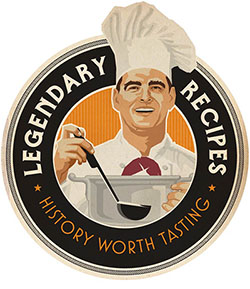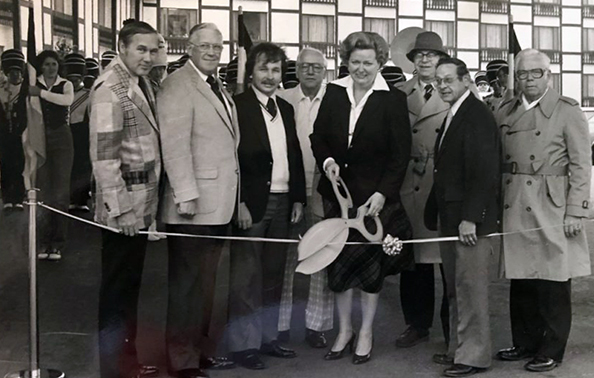Arthur’s made its debut in 1980 as part of an ambitious initiative to revitalize the central business district of Elkhart, Indiana, a city widely known as the “Band Instrument Capital of the World.” Located at 300 Main Street in downtown Elkhart, the restaurant was joined to the Midway Motor Lodge, a $5.5 million hotel that was the cornerstone of the “City Centre” development that local leaders had devised in the late 1960s to attract visitors and stimulate the local economy.
The hotel—the 19th in the Midway chain—opened its doors on July 22, 1980, with Terry Carrick, the lead investor in its Milwaukee-based ownership group, announcing that 15,000 reservations for meals at Arthur’s were already on the books. Because of various construction delays, however, only a third of the hotel’s 180 rooms were ready for occupancy on opening day, and there were just three paying guests on the first night. Nonetheless, Carrick projected confidence about Elkhart’s future. “I don’t think your town as a whole is in that bad a shape,” he said that day. “I think your economy is more diversified than most people give it credit for.”
It would be another three months before Arthur’s—named for Arthur Aldendorf, the Wisconsin-based restaurateur chosen to operate it—opened its doors. The 19,500-square-foot restaurant had four separate dining areas, including a huge banquet hall, with seating for more than 700 patrons. Two adjoining venues, the Irish Pub and Aldie’s Show Lounge, pushed the total seating capacity to over 1,000.
Arthur’s got off to a very good start. Under a headline that branded it the “crown jewel” of the entire City Centre development, a reviewer for the daily newspaper in nearby South Bend gushed that the residents of Elkhart “have every reason to glow over a sharp, stylish restaurant that has returned gracious dining to a gastronomically undernourished downtown area.”
By the end of the decade, however, the Midway Motor Lodge was in financial trouble, with Arthur’s struggling in its wake. In May 1990 the hotel’s parent company filed for Chapter 11 bankruptcy protection—reporting assets of $4.3 million against debts of $5.5 million—to stave off a foreclosure action by Midwest Commerce Bank, which claimed that it had fallen more than $500,000 behind on its mortgage payments. The Midway Motor Lodge’s attorney argued that the business was fundamentally sound but had suffered at the hands of external economic factors, including the loss of commuter air service between Elkhart and Chicago O’Hare Airport. Others noted that the hotel had been the first and maybe the only in the Midway chain to be situated away from an interstate highway.
In March 1990 the judge presiding over the bankruptcy case appointed Marshall Management Inc., a Maryland-based company that specialized in rescuing financially troubled hotels, to be the receiver for the Midway Motor Lodge. This appointment, however, did not extend to Arthur’s, the Irish Pub, and Aldie’s Show Lounge, which continued to operate under the ownership of the company Carrick had originally set up as a tax shelter for its Milwaukee-area investors.
In 1991 Marshall Management rebranded Midway Motor Lodge as the Quality Hotel City Centre. It also undertook a “floor to ceiling” remodel of Arthur’s and announced that the restaurant would be renamed Plaza I.
Despite the renovations and rebranding, the hotel and restaurant continued to struggle. At one point the restaurant returned to operating under its original name, but after the Elkhart County Health Department briefly closed the reincarnated Arthur’s for numerous health code violations, a new owner reopened it under another name.
In the years to come the development would be seen as “a blight on the downtown,” as a reporter for the Elkhart Truth put it. The city of Elkhart eventually acquired the property in 1998 for $850,000 and demolished everything the following summer.
toto slot monperatoto
Sweet Charity Pie
Soon after Arthur's opened in Elkhart, Indiana, in 1980, a reviewer for the daily newspaper in nearby South Bend gushed that the city had “every reason to glow over a sharp, stylish restaurant that has returned gracious dining to a gastronomically undernourished downtown area.” This pie, which first gained popularity in the 1970s and was featured on the original menu at Arthur's, combines a buttery nut crust, tangy cream cheese, and cherry-laden whipped cream. (Although the dessert's origins are unknown, its name almost certainly was a nod to the musical "Sweet Charity," which debuted on Broadway in 1966 and was adapted into a film in 1969.
Ingredients
- 1 cup all-purpose flour
- 1/2 to 1 cup finely chopped nuts (pecans or walnuts work well)
- 1/4 cup firmly packed brown sugar
- 1/2 cup unsalted butter or margarine, softened
- 8 ounces cream cheese, softened
- 1/2 teaspoon almond extract
- 1 cup powdered sugar, plus extra for whipped cream
- 1 (21-ounce) can cherry pie filling
- 1 cup heavy cream, whipped and sweetened to taste
Instructions
Preheat the oven to 375 degrees. In a 9-by-13-inch (3 quart) baking dish, combine the flour, nuts, brown sugar, and butter. Mix until crumbly, then bake for 15 to 20 minutes, stirring once midway, until golden brown. Reserve 1/2 cup of the crumb mixture for topping. Firmly press the remaining warm crumbs into a 9- or 10-inch pie plate to form an even crust. Let cool, then chill.
In a medium bowl, beat the cream cheese, almond extract, and powdered sugar until smooth and fluffy. Spread this mixture evenly over the chilled crust.
Gently fold the cherry pie filling into the whipped cream until combined. Spoon the mixture over the cream cheese layer, smoothing the top. Sprinkle with the reserved crumb mixture.
Refrigerate for 1 to 2 hours until set. Slice and serve chilled. Store leftovers in the refrigerator.










No Comments